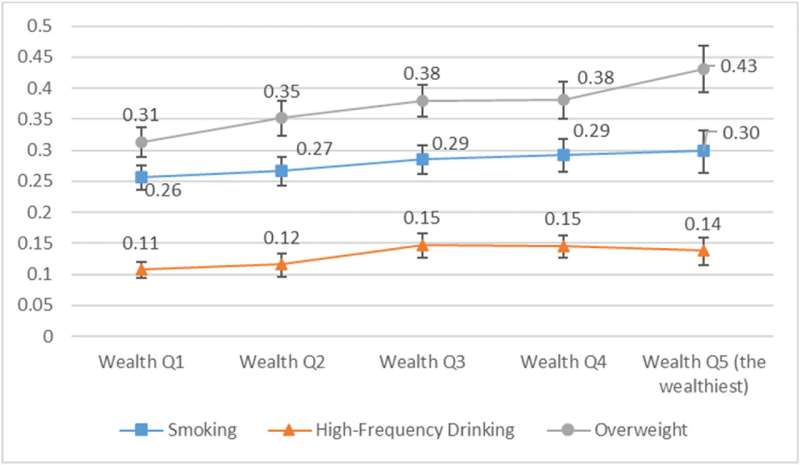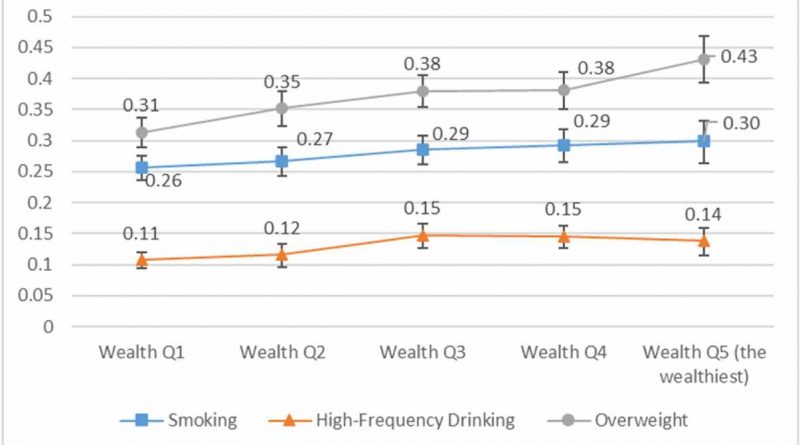Study shows counterintuitive results on association between wealth, education and health outcomes in China

New research from the University at Buffalo examining the relationship between behavior and health outcomes in China suggests that education and wealth are not necessarily tied to better health, in contrast to what studies have found in many Western countries. In some cases, higher socioeconomic status in China is associated with similar—or even worse—health outcomes.
That’s a powerfully instructive finding, considering that the association between education and health, in particular, is one of the strongest relationships in the social sciences. But the research leading to that collectively robust conclusion has relied mostly on samples from Western countries.
For a more global perspective, Rui Huang, a graduate student in the UB Department of Sociology, and Hanna Grol-Prokopczyk, Ph.D., an associate professor of sociology in the university’s College of Arts and Sciences, decided to look at China. Recent public health achievements in China have slowed in recent decades along with an accompanying steady and substantial increase in chronic health conditions, they say.
The results of their paper, published in the journal SSM-Population Health, used data from part of the 2015 China Health and Retirement Longitudinal Study, a representative sample involving 14,000 participants aged 45 and above living in China. The findings can guide policy initiatives that encourage healthier lifestyle choices in the most populous nation in the world, while also illuminating how cultural practices can impede as well as improve health globally.
“What stands out in this research is that risky behaviors are damaging population health in China even among people at the top of the social hierarchy, a finding we don’t see in studies in the West, where higher socioeconomic status leads to better health outcomes,” says Huang, the paper’s first author.
The researchers found that education and wealth are associated with better self-reported health and lower risk of arthritis, but they found no significant socioeconomic disparities in diabetes or hypertension. Moreover, they found greater prevalence of high cholesterol, overweight/obesity, smoking, and high-frequency drinking among the highly educated and/or wealthy in China.
Both culture and context, often absent from consideration in Western research samples, might be driving the current study’s counterintuitive findings, according to Huang.
“There are specific cultural meanings embedded in high-risk behaviors like smoking and alcohol consumption in China, particularly among middle-aged and older adults,” she says. “Cigarettes and alcoholic beverages are at the center of social courtesy in Chinese society, and gifting luxurious cigarettes and liquor is a prevailing way to facilitate interpersonal relationships, display social position, build social networks, and benefit business affairs.
“These types of behaviors and risk factors are not only socially accepted, but encouraged. This may outweigh the otherwise protective effects of high socioeconomic status, which provides resources that can help avoid risks, adopt preventative strategies, minimize disease and promote good health.”
The study also accentuates the fault lines that became visible when generalizing research involving health and social status across populations with different economic, political, historical and cultural circumstances.
The patterns surfacing in one world region do not always apply somewhere else, but the research also invites consideration for how local cultural norms might be shaping health outcomes, according to Grol-Prokopczyk.
Source: Read Full Article



